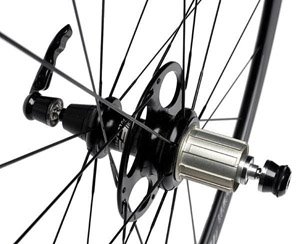 I have been meaning to say something about these FSA RD-600 wheels for a long time, but it is one of the many topics that I just never got around to posting about. You see, I like FSA and I think they make really good products. I have an FSA crankset on my cross bike and I am very happy with it. Still, when I first saw these wheels with triple flange hubs and spokes in the center, I was a bit skeptical. We all know that spoked wheels work under tension. Basically, spokes from one side of the hub pull the rim to oppose the force from the spokes on the opposite side. So what are these spokes in the middle really doing? I don’t see how they really can contribute to the lateral structural integrity of the wheel. FSA claims that, by tucking a third of the spokes in line with the rim, they are sheltered from airflow and create a more aerodynamic wheel. I don’t doubt that, but is there a trade off? I guess my real question is this; is this concept a true innovation or just a marketing gimmick to differentiate FSA’s product from the masses of road wheels on the market?
I have been meaning to say something about these FSA RD-600 wheels for a long time, but it is one of the many topics that I just never got around to posting about. You see, I like FSA and I think they make really good products. I have an FSA crankset on my cross bike and I am very happy with it. Still, when I first saw these wheels with triple flange hubs and spokes in the center, I was a bit skeptical. We all know that spoked wheels work under tension. Basically, spokes from one side of the hub pull the rim to oppose the force from the spokes on the opposite side. So what are these spokes in the middle really doing? I don’t see how they really can contribute to the lateral structural integrity of the wheel. FSA claims that, by tucking a third of the spokes in line with the rim, they are sheltered from airflow and create a more aerodynamic wheel. I don’t doubt that, but is there a trade off? I guess my real question is this; is this concept a true innovation or just a marketing gimmick to differentiate FSA’s product from the masses of road wheels on the market?
Recently, I saw someone with a set of these wheels on a ride, so I asked how he liked them. His response was not favorable. Among other things, he said that the wheels do not stay true. Of course, that is just one person’s opinion. I have not ridden these wheels myself so I cannot speak first hand as to how they work. I do think that FSA has a well-deserved good reputation, so I do not believe that they would release a product that doesn’t work well. As I said before, I am skeptical, but curious about these wheels. If any of you have ridden or currently ride these wheels, let me know what you think about them.
Photo from Cycling News

Leave a Reply to James Cancel reply